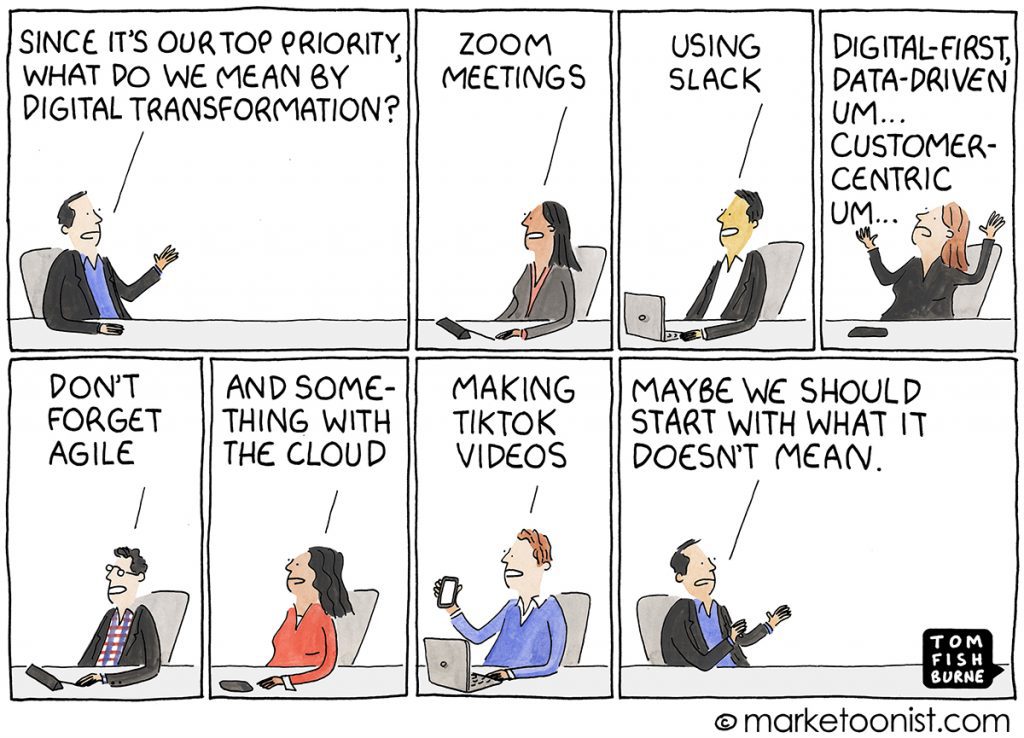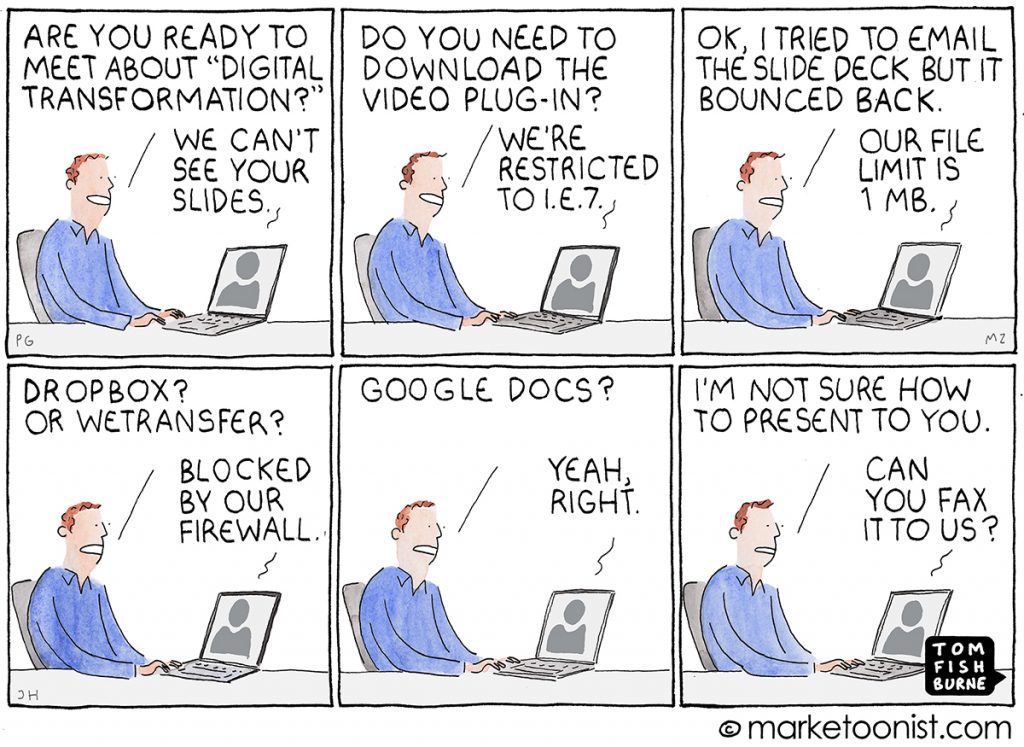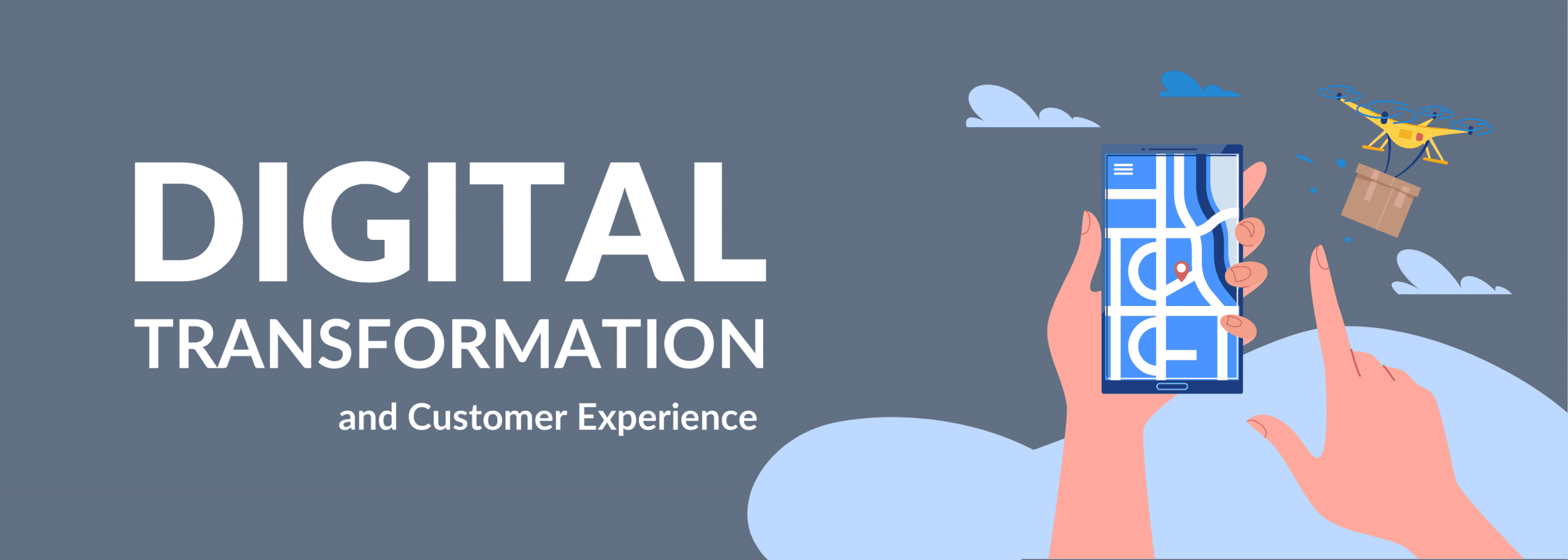What Is the Connection Between Digital Transformation and Customer Experience?


Looking at these cartoons, you can easily guess that I am a big fan of Tom Fishburne, aka marketoonist. These, in my mind, define the depth of digital transformation as we see it today.
BPOs, in the last decade or so, started focusing on enhancing the customer experience journey. They started investing in digital transformation initiatives.
Every organization has gotten on the bandwagon of digital transformation, and every organization is at some stage in its digital transformation journey.
Check this article on: How Digitization in Banking sector is transforming banking contact center
Tom Fishburne further came up with this definition for the Martec’s law. Technology changes exponentially, while organizations change logarithmically.
The barriers that the protagonist in this cartoon runs into are not technical – they are managerial. It is management choices that limit file sizes, standardize on a single web client, block services at the firewall, forbid collaborative cloud apps, etc.
Organizations tend to look at digital transformation as a technology initiative. In fact, it should be the reverse. It should be a business initiative.
And, your customers should be at the center of everything you do.
The customer experience across the entire customer journey should be made remarkable with your digital transformation.
Does That Give You the Clarity Now?
I am not sure. Let us spend some time understanding digital transformation and customer experience.
The operative word in digital transformation is ‘transformation.’ What holds right for you may not be right for me when it comes to transformation. Besides, it is not just about adding digital technologies – it should help me improve my process and allow me to identify newer business opportunities.
It should provide a better experience for my customers to improve and enhance their engagement levels with my offerings.
With the customer at the center, let us look at some of the use cases:
- For a fast-food chain, digital transformation is about installing touch screen kiosks or using AI to predict menu-item demand.
- For a manufacturing company, it would mean implementing IoT to enhance the productivity
- For a bank, it would mean adding voice assistants to your mobile app
- For the hospitality industry, it would mean using AI to know the guest’s preferences before they check-in. I enter my room and find my favorite wine lying on the table with ‘complimentary’ written on it. Just imagine the excitement that I would go through
- For the retail outlet, sending custom offers to your customers, especially when they are in your vicinity, based on their offline and online shopping preferences would mean a world of good.
In each of these use cases, the transformation part is the one that is driving the digital part, and not the other way around.
The Tale of the Tables – The Strength of Digital Technologies
One wouldn’t expect that changing the size of tables in an employee cafeteria could be symbolic of the digital transformation of a business.
The tables in question were in the offices of a travel company working with Humanyze, a people-analytics company headquartered in Boston that is a spinoff of the MIT Media Lab.
Humanyze integrates wearables, sensors, digital data, and analytics to identify who talks to whom, where they spend time, and how they talk to each other. The analysis identifies patterns of collaboration that correlate with high employee productivity.
Humanyze analyzed the travel company’s workforce and discovered that people eating lunch together shared important insights that made them more productive. In addition, the analysis showed that productivity went up based on the number of people at the same table.
Humanyze found that employees typically lunched with either four or 12 people. A quick inspection of the cafeteria solved the puzzle – all the tables were either for four or 12 people. The integration of digital technologies pointed the way to increasing table sizes, which had a direct and measurable impact on employees’ ability to produce.
The tale of the tables is a powerful example. The strength of digital technologies – social, mobile, analytics, and cloud – doesn’t lie in the technologies individually. Instead, it stems from how companies integrate them to transform their businesses and how they work.
The Digital Dominos
In 2009, Domino’s pizza was boring counters with just a couple of tables and self-service.
Some of the customer feedback that Domino’s received were:
- Domino’s crust tastes like cardboard
- The sauce tastes like ketchup
- This is an imitation of a pizza
Fast forward to 2020, Domino’s has clocked in annual revenue of $14 billion in FY2019 through its 17020 restaurants across the world. The 11% YoY growth helped the company gain a net income of $400 Mn.
Domino’s turned things around by first acknowledging that its pizza sucked. Then Domino’s launched a campaign, “Oh yes, we did.” Their “Oh yes, we did” showed their consumers that they have indeed been listening to what they have to say – but it also showed how Dominos has done.
How Did All This Happen?
Led by Patrick Doyle, Domino’s pursued a multi-pronged strategy mainly relying on digital transformation.
- Domino’s got rid of their 49 years old recipe. Now they included delicious garlic, buttery crust, and added a category “Specialty Pizza,” consisting of lightly breaded chicken topped with cheese and exotic toppings such as bacon and jalapeno.
- The real change came with the digital transformation of the supply chain. This step completely changed the brand perception of Domino’s from a pizza delivery company to a technology company.
Domino’s Invested Heavily in Digital Capabilities
2008: Domino’s launched its “pizza tracker” technology to keep customers updated on the progress of their orders. The technology allows Domino’s to extend its centralized services such as supply chain management and IT to its franchises, thus simplifying the franchise’s operations and improving cost management.
2011: Domino’s launched its iPhone application, allowing customers to order on the go. The mobile-first approach worked exceptionally well for the brand. Mobile ordering quickly became the dominant ordering channel.
2015: Domino’s launched Anyware, allowing customers to order from anywhere and anytime through any device. Customers can order from a plethora of devices, including Amazon Echo, Google Home, Siri, Smartwatches, Smart TVs, Slack, Facebook Messenger, Twitter, and more.
2016: Domino’s shocked the world with the first-ever Drone delivery of pizza in New Zealand (Trivia: It was a peri-peri chicken pizza and a chicken and cranberry pizza – YOU CAN ASK THIS AS A QUESTION)
June 2020: Domino’s launched “Domino’s car side delivery service” as its way to fight against COVID but through digital transformation in its carryout method. Customers now have an option in the application or website to choose Domino’s car side delivery. Customers now have an opportunity to stay in the vehicle of their preference. Be it the back seat or trunk, making the entire process contactless, convenient, and safe.
Domino’s evolved from a pizza delivery company to a technology company in this process. Half of its workforce at its headquarters is in software and analytics.
All the digital transformation that Domino’s made is focused on making the customer experience and engagement better. That should be the core of any digital transformation initiative.
Domino’s has made pizza ordering practically as easy as breathing.
How Do I Bring About Digital Transformation?
Your agents are the ones who listen to your customers closely. Bring together all of the feedback – focus on the negatives.
Acknowledge that problems exist.
Figure out how to address those problems and what kind of technology infrastructure is needed for them. Every process requires a different approach. What works for a fintech process may not be relevant for an edtech process.
Empower your employees, engage your customers, improve your operations, and digitize to achieve strategic objectives. Your digital transformation initiatives would move towards a unified goal of enhancing customer experience across the entire customer journey.
